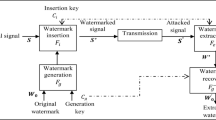Abstract
Watermarking methods have traditionally emerged from the imperative to guarantee the authenticity of digital documents. As we navigate the current landscape of advancing voice imitation and forgery techniques, safeguarding forensic evidence signals, historic speeches, and music signals has become an urgent challenge. A notable concern with existing methods is the presence of blind spots—areas where tampering goes undetected—significantly impacting detection sensitivity and rates. To address these challenges, this research introduces a fragile audio watermarking method designed to identify even the slightest modifications in audio signals. The approach relies on embedded nested SHA-256 hashes. Performance evaluation demonstrates that any inversion of a bit in the watermarked signals is promptly detected on the blind side of detection. Notably, blind spots are minimized, leading to a remarkable 100% detection rate. Furthermore, comparative results highlight the lightweight nature of the watermark, ensuring high signal imperceptibility.





Similar content being viewed by others
Data availability
All data and audio samples utilized in this research are available upon request. Researchers interested in obtaining access to the supplementary materials may contact the corresponding author.
References
Bassia P, Pitas I (1998) Robust audio watermarking in the time domain. Eur Signal Process Conf 1998, 1934:535–546
Arnold M (2000) Audio watermarking: Features, applications and algorithms. In 2000 IEEE International conference on multimedia and expo. ICME2000. Proceedings. Latest advances in the fast changing world of multimedia (cat. no. 00TH8532), vol 2. IEEE, pp 1013–1016. https://doi.org/10.1109/icme.2000.871531
Zhang J, Han B (2011) Fragile audio watermarking scheme based on sample mean sequence. In: 2011 International Conference on Multimedia Technology. ICMT 2011, (no. 2, pp. 333–336). https://doi.org/10.1109/ICMT.2011.6003041.
Vestman V, Kinnunen T (2020) Voice Mimicry Attacks Assisted by Automatic Speaker Verification. Comput Speech Lang 59:36–54
Djebbar F, Ayad B, Meraim KA, Hamam H (2012) Comparative study of digital audio steganography techniques. EURASIP J Audio Speech Music Process 2012, 1:1–16. https://doi.org/10.1186/1687-4722-2012-25
Alsabhany AA, Ali AH, Ridzuan F, Azni AH, Mokhtar MR (2020) Digital audio steganography: systematic review, classification, and analysis of the current state of the art”. Comput Sci Rev 38:100316. https://doi.org/10.1016/j.cosrev.2020.100316. Elsevier Ireland Ltd
Hu HT, Chou HH, Lee TT (2021) Robust blind speech watermarking via FFT-Based perceptual vector norm modulation with frame self-synchronization. IEEE Access 9:9916–9925. https://doi.org/10.1109/ACCESS.2021.3049525
Su Z, Zhang G, Yue F, Chang L, Jiang J, Yao X (2018) SNR-Constrained heuristics for optimizing the scaling parameter of robust audio watermarking. IEEE Trans. Multimed. 20(10):2631–2644. https://doi.org/10.1109/TMM.2018.2812599
Renza D, Ballesteros DML, Lemus C (2018) Authenticity verification of audio signals based on fragile watermarking for audio forensics. Expert Syst Appl 91:211–222. https://doi.org/10.1016/j.eswa.2017.09.003
El-Khamy SE, Korany NO, El-Sherif MH (2017) A security enhanced robust audio steganography algorithm for image hiding using sample comparison in discrete wavelet transform domain and RSA encryption”. Multimed Tools Appl 76(22):24091–24106. https://doi.org/10.1007/s11042-016-4113-8
Al-Haj A (2014) An imperceptible and robust audio watermarking algorithm. EURASIP J Audio Speech Music Process 2014(1):1–12. https://doi.org/10.1186/s13636-014-0037-2
Khare D, Verma S, Gupta R, Chandel GS (2013) Analysis of 3 dimensional object watermarking techniques”. Lect Notes Electr Eng 150(LNEE):457–463. https://doi.org/10.1007/978-1-4614-3363-7_53
Hu HT, Lee TT (2019) Hybrid Blind audio watermarking for proprietary protection, tamper proofing, and self-recovery. IEEE Access 7:180395–180408. https://doi.org/10.1109/ACCESS.2019.2958095
Zhou S, Song M, Qian Q, Liao W, Gong X (2022) GRACED: a novel fragile watermarking for speech based on endpoint detection 2022
Hurrah NN, Parah SA, Loan NA, Sheikh JA, Elhoseny M, Muhammad K (2019) Dual watermarking framework for privacy protection and content authentication of multimedia”. Futur Gener Comput Syst 94:654–673. https://doi.org/10.1016/j.future.2018.12.036
Prasad S, Pal AK (2020) Hamming code and logistic-map based pixel-level active forgery detection scheme using fragile watermarking”. Multimed Tools Appl 79(29–30):20897–20928. https://doi.org/10.1007/s11042-020-08715-x
Mosleh M, Setayeshi S, Barekatain B, Mosleh M (2021) A novel audio watermarking scheme based on fuzzy inference system in DCT domain”. Multimed Tools Appl 80(13):20423–20447. https://doi.org/10.1007/s11042-021-10686-6
Funding
This work received support from the research support program et al.-Maarif University College (uoa.edu.iq) under the reference number (UOA—202356598).
Author information
Authors and Affiliations
Corresponding author
Ethics declarations
Conflict of interest
The authors affirm that they have no known competing financial interests or personal relationships that could have influenced or biased the work reported in this paper. This declaration ensures the integrity and impartiality of the research findings.
Additional information
Publisher's Note
Springer Nature remains neutral with regard to jurisdictional claims in published maps and institutional affiliations.
Rights and permissions
Springer Nature or its licensor (e.g. a society or other partner) holds exclusive rights to this article under a publishing agreement with the author(s) or other rightsholder(s); author self-archiving of the accepted manuscript version of this article is solely governed by the terms of such publishing agreement and applicable law.
About this article
Cite this article
AlSabhany, A.A., Ali, A.H. & Alsaadi, M. A lightweight fragile audio watermarking method using nested hashes for self-authentication and tamper-proof. Multimed Tools Appl 83, 89135–89149 (2024). https://doi.org/10.1007/s11042-024-18930-5
Received:
Revised:
Accepted:
Published:
Issue Date:
DOI: https://doi.org/10.1007/s11042-024-18930-5




